This article explains everything you need to know to fully understand Amazon affiliate links. There are a lot of linking options, and some are better than others. Find out which link types are the best, learn how to identify Amazon affiliate links, discover the best Amazon affiliate WordPress plugin, and more.
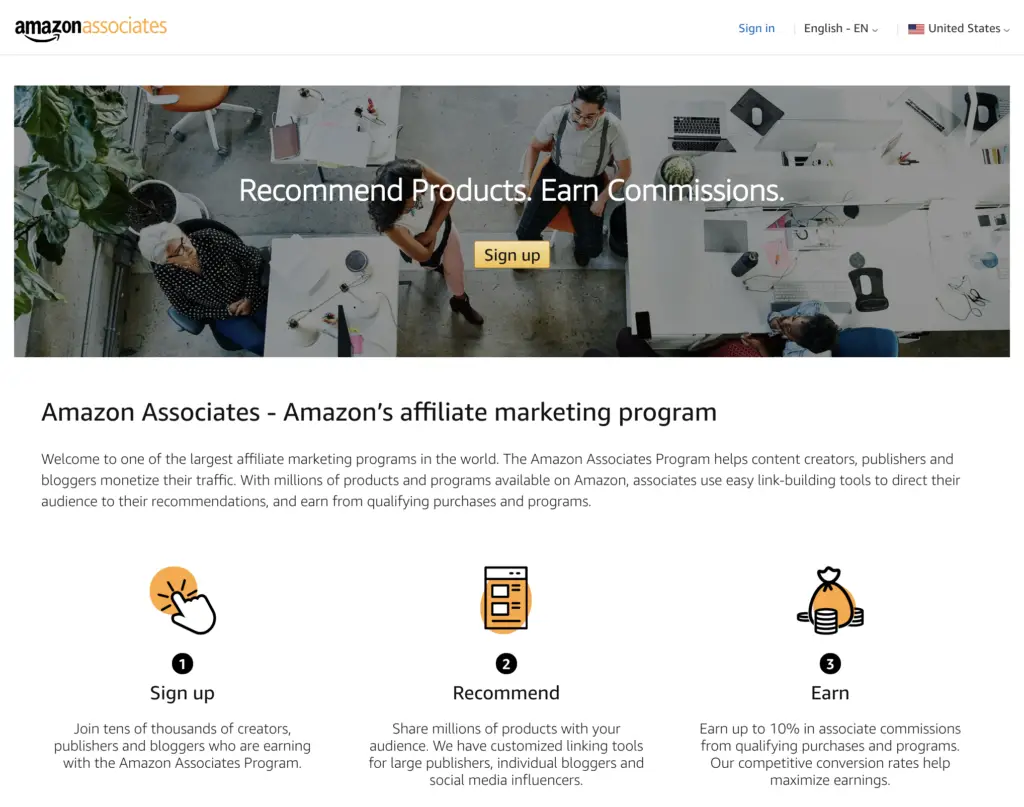
The Amazon affiliate program, properly called the Amazon Associates Program, is an official profit-sharing program that Amazon offers for free to web content publishers, bloggers, niche site builders, and influencers. It is one of the most popular affiliate marketing programs today. I can’t think of a larger affiliate marketing program.
When you refer visitors to the Amazon affiliate program through your special Amazon affiliate links that are attached to your Associate’s ID, and those visitors purchase things on Amazon, you are credited with commissions (referral fees) on the items those visitors purchased.
Here are the supported Amazon affiliate countries. You can check to see if your country has an Amazon affiliate program. It is easy and free to become an Amazon affiliate.

Amazon affiliate links are special links that are attached to your Amazon Associate’s ID you can embed in your website posts and pages. When you send web visitors to Amazon through the special links on your affiliate website, you earn referral fees (affiliate commissions) on the purchases those visitors make in the next 24 hours.
There are a few different types of Amazon affiliate links that we will discuss in more detail below, including:
When an online visitor or somebody in your social media audience clicks one of your affiliate links, they are redirected to Amazon and a cookie is set in the user’s web browser or social media app, that stores your Associate’s ID for 24 hours.
This means that you will earn referral fees or commissions on most items in purchases that the visitor makes within 24 hours. You earn commissions not only on the item you sent the visitor to but anything that person buys that commissions are offered on.
It;’s good to note that there are some categories that do not pay commissions. Make sure you are not promoting categories that pay nothing!
Sometimes a web user clicked on somebody else’s affiliate link first, then clicks on your link. Who gets the commission? The first affiliate or last affiliate? The answer is that the last affiliate whose link was clicked gets the commission. This is called last-click attribution.
There is debate on which click attribution model is best, with many different types, some more complex than others.
Like many affiliate programs, Amazon uses the simple last affiliate link that was clicked will earn the referral fees.
The first step to getting your affiliate links is to sign up for the free Amazon Associates program. You can get started with our Amazon affiliate countries page that will get you started in the right direction. Sign up for the affiliate program in your country if available, or choose another country. Generally, the US, Canada, or India programs have the largest market shares.
Once you are officially an Amazon Associate, you can get your Amazon affiliate links in many different ways. Here is a list of your choices.
First, we will look at the minimum required element of an Amazon affiliate link. Here is a simple full link example.
https://www.amazon.com/dp/B07FYKN2Y9/?tag=YOURASSOCIATEID-20
The easiest way is to inspect the link and look for a string of text that starts with tag= followed by a string of letters, numbers & hyphens that ends in -20, or another number. Look for something similar to:
tag=YOURASSOCIATEID-20
Here are a few examples of Amazon affiliate links you can use to compare any link to, to help you detect Amazon affiliate links. These all lead to the same product page and are All valid Amazon affiliate links.
Example regular long URL: https://www.amazon.com/dp/B08PHPLLS6?_encoding=UTF8&aaxitk=FkIEy8LIJA8u6ENE12NzAA&hsa_cr_id=4574972480701&pd_rd_plhdr=t&pd_rd_r=33d53caf-3184-40ff-96bb-b5e0e2772e9d&pd_rd_w=c0gla&pd_rd_wg=0LCIV&linkCode=li2&tag=YOURASSOCIATEID-20&linkId=bc63d216db3aebc9299ec4e7511d24ba&language=en_US&ref_=as_li_ss_il
This is an example of a regular product details page URL with an affiliate ID attached. You can see the example affiliate ID in bold in the URL. This URL is used by Amazon in the official SiteStripe tool in their image links.
Example shortened URL: https://amzn.to/3scJgqp (can’t tell it is an affiliate link)
When using the linking tool SiteStripe, the linking tool generates a short URL for you when you create a text URL. This link does not show that it is an Amazon affiliate link, but it is from Amazon themselves so it is a 100% valid link.
Example PAAPI5 URL: https://www.amazon.com/dp/B08PHPLLS6?tag=YOURASSOCIATEID-20&linkCode=osi&th=1&psc=1
This is what a URL that comes from the Product Advertising API looks like. Often referred to as the ‘Amazon API’ – this URL is generated when product information or images are pulled from the API. The API is the only way aside from SiteStripe to display Amazon product images without breaking their operating agreement.
Custom URL: https://www.amazon.com/dp/B07FYKN2Y9/?tag=YOURASSOCIATEID-20
You can also build your own simple custom URLs, using just the basic required elements. These links will pass the test when you use Amazon’s link testing tool.
Jesse Lakes from Genius Links discusses why knowing the anatomy of an Amazon affiliate link is important on this podcast over at Kindlepreneur.
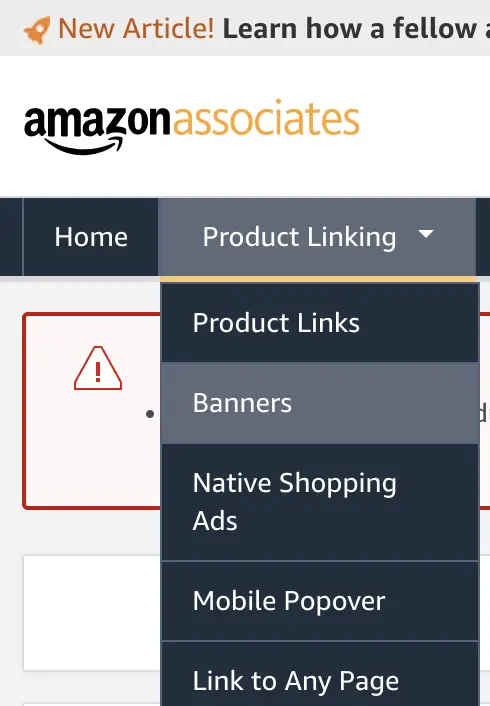
Amazon offers a few different linking options within your affiliate account, one of them being banners. When logged into your Amazon Associate account, under the main menu “Product Linking” dropdown you’ll find the Banners section.
Amazon doesn’t create graphic advertising banners for many products, but you can see the categories you can get banners for. Your options are limited here. If you do promote any of these products, these banners could prove useful.
Overall Amazon’s own link types are limited. Sure they work, but there are much better options out there that can even help you increase your earnings.
If you have established website traffic and are not using an Amazon affiliate WordPress plugin, you are missing out on easy commissions and making less than you should be. There are easy ways to increase your affiliate earnings.
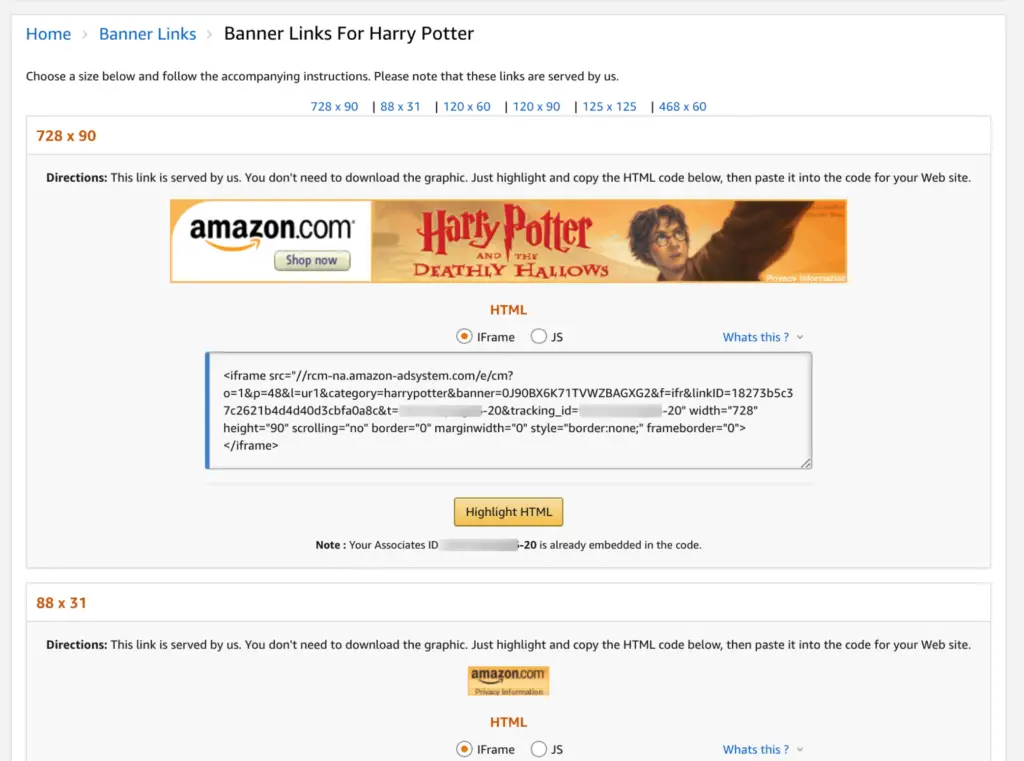
Using Amazon’s SiteStripe linker is the default way that Amazon provides you for obtaining your affiliate links. There are however more elegant solutions, especially if you run a WordPress website.
Finding and inserting products can be very time-consuming.
If you have a WordPress website and publish more than an occasional blog post, you should consider using an Amazon affiliate WordPress plugin to save you time, manage your links better, increase your click-through rates, gather useful click data, and ultimately make more money. These are some great affiliate marketing plugins that pay for themselves easily and more.
* Important to note, if you are a new Amazon affiliate you will not get access to the Product Advertising PA-API5, and most Amazon WordPress plugins require access to this API to even work at all.
Here is where AmaLinks Pro® comes in.
AmaLinks Pro® is the best Amazon affiliate WordPress plugin around. It’s great for niche sites, affiliate websites, or any WordPress website really, and here’s why.
AmaLinks Pro® is a premium WordPress plugin that helps Amazon affiliates insert multiple types of links easily. This can save you a lot of time and even help you make more money faster! It’s a great way to improve your website’s user experience.
You can read about all of our features, check out our demo page, or browse our learning center.
One important thing to remember about AmaLinks Pro® is that we have a No-API mode for beginner affiliates that provides you with almost all of our plugin’s functionality!
For now, let’s take a look at the types of links you can insert with AmaLinks Pro®.
For AmaLinks Pro® users with API access, you can easily search Amazon right within your dashboard and insert plain text links anywhere you want as long as your post or page has a content editor. This is the quickest way to find products and insert plain text links into your website right within the editor.
Our API Image links allow you to choose from ANY of the available product images and insert them with an affiliate link. Website visitors very often click product images, and it’s generally a good idea to have your product images linked, or you are likely missing out on some commissions.
Another linking option that AmaLinks Pro® gives you is creating a custom CSS button. This works well if you are publishing a product review post. Adding a nice CTA button call to action in a few strategic places can help you maximize your post’s earnings.
 AmaLinks Pro® – Product Showcase Boxes
AmaLinks Pro® – Product Showcase BoxesThis is where AmaLinks Pro® really shines. AmaLinks Pro® product showcase boxes have proven to increase CTR time and time again. Here are a few AmaLinks Pro® case studies we ran in cooperation with a few of our customers, and we increased the click-through rate on all three test posts by 256%, 263%, and a whopping 386%! That equals quite a few commissions these affiliates were missing out on.
If you are not adding beautiful product showcase boxes to your posts with related products, you are missing out on more commissions.
Responsive Product Comparison Tables are another excellent way to provide your visitors with some high-value interactive buyer-centric content. You can easily increase a post’s conversion rates using a comparison table.
People can’t seem to resist clicking on images and buttons within the tables. I’m sure you’ve seen these product comparison tables around on various affiliate sites when you were doing your own consumer product research.
AmaLinks Pro® offers the only easy-to-use drag and drop table builder. You can add comparison charts filled with related products within just a few minutes.

The simple definition of link cloaking is obscuring a real URL by creating a shorter cleaner link that redirects to the real link, thereby disguising the real link destination.
This technique is often used by affiliates to effectively hide their affiliate tracking ID to protect themselves from link theft.
Amazon Says this about cloaking links:
“You will not cloak, hide, spoof, or otherwise obscure the URL of your Site containing Special Links (including by use of Redirecting Links) or the user agent of the application in which Content is displayed or used such that we cannot reasonably determine the site or application from which a customer clicks through such Special Link to the Amazon Site.”
– Program Participation Requirements, Section 6. (v) “Content on your Site
Matt Mustarde over at Geniuslinks says it best:
“This is Amazon’s only reference to “cloaking” in their Program Policies documentation, and this is where most of the confusion stems from. When Amazon uses the term “cloak” in this context they’re actually referring to the act of obscuring the referring URL of the site that the link is being clicked from. This can be done by adding multiple redirects between the link on the site and the end destination, or by spoofing the referrer header so that it’s not possible to tell where the click came from.”
What it does not say is that using a shortened link is against the rules.
Here is what Amazon says about using shortened links:
“You will not use a link shortening service in a manner that makes it unclear that you are linking to an Amazon Site.“
– Program Participation Requirements, Section 6. (w) “Content on your Site
So, you can use a link shortening service such as bit.ly or other link shortening services – as long as you make it clear that the link leads to Amazon.
The Amazon Associates program operates in at least 19 different countries. You can learn about what Amazon affiliate countries are supported in our guide.
Amazon allows an affiliate to sign up for their program in multiple countries and redirect your links to the proper Amazon country locale for the visitor. This is called Amazon link localization, or geo-targeting.
If a visitor in Canada clicks a localized link, they will get directed to the Amazon.ca website to view the product. If another user in the United States clicks the exact same link – they will get directed to Amazon.com to view the product. This is link localization.
There are a couple of ways to localize your Amazon Associate links.
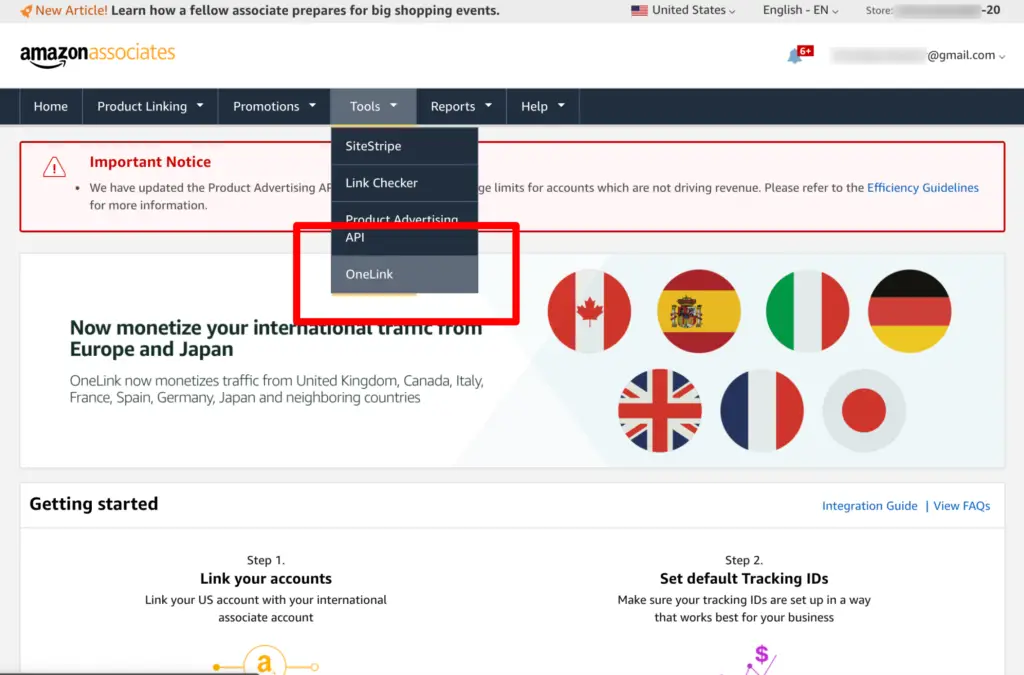
Amazon OneLink is Amazon’s own link localization script. You set it upright within your Associate’s account, and add a small JavaScript snippet to your web pages. If you search Google for “Amazon OneLink” you’ll see a lot of people have issues with the service.
There is a much better option that we recommend, and compliments AmaLinks Pro® perfectly!
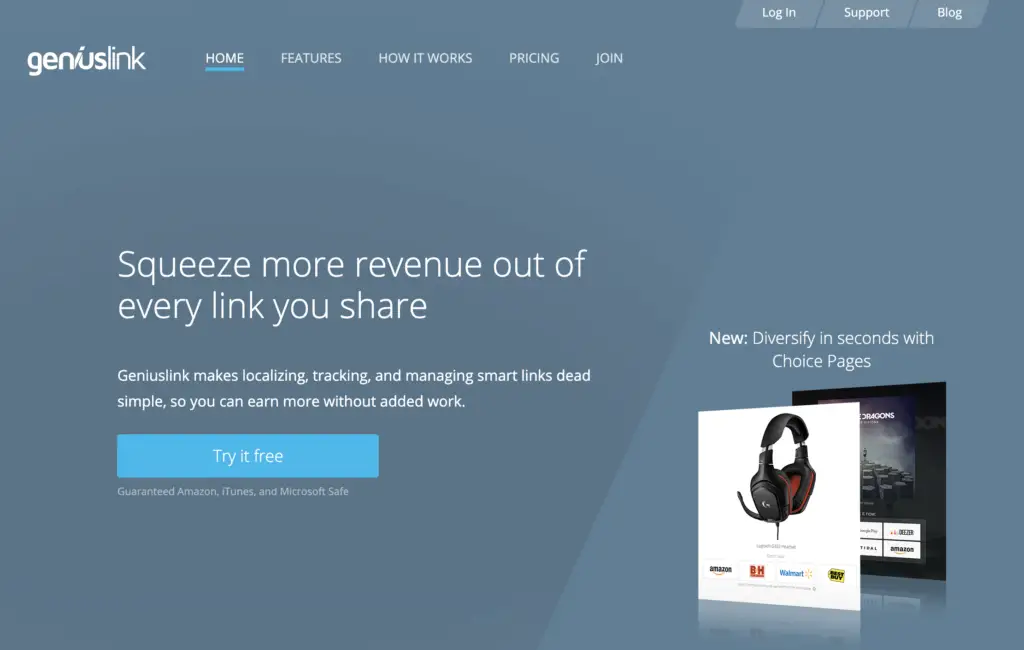
Genius Link is SO much more than just a link localizing tool – but link localization is one part of their offering that they do VERY well. Here’s how it works…
Genius Link detects a shopper’s country, language, device, and more, then routes them to the best page for them. It’s automatic for Amazon, iTunes, and Microsoft. Plus, you can define custom destinations for any other affiliate program. Unlike Amazon OneLink, we support ALL major Amazon storefronts and our localization leads the way in accuracy. (Credit: Genius Links)
In much the same way as Amazon OneLink – Genius Link offers a simple script (a piece of code) that you insert into your website and it automatically converts all of your existing and future links. To make things even easier – they offer a WordPress plugin that you can install if you’re not comfortable placing code on the back end of your site.
We at AmaLinks Pro® are big fans of Genius Link and it is what we use for Amazon link localization on our personal sites. We’ve tested it thoroughly and Genius Link works for converting ALL link types created by AmaLinks Pro®.